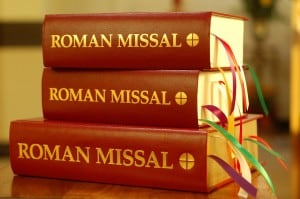Editor’s Note: this is the second part of Jeff Johnson’s essay “Words, Words, Words.”
If you missed part 1 you can read it here.
***
The History of Latin as a Sacred Language and the New Translation of the Roman Missal
It’s good to be the king. You get to do strange linguistic experiments like the one conducted on the remote island of Inchkeith by King James IV of Scotland. He placed two newborn children there along with a mute nursemaid, and then prohibited anyone from speaking in their presence. He wished to discover which language would spontaneously burst forth from the mouths of the babes, thereby discovering the original language of humankind. By his own account and, no doubt, to the surprise of the maid, the two began speaking “good Hebrew.”
James was not the first to try this. King Psammetichus I, a 5th century BC ruler of Egypt, similarly placed two children with a mute goatherd. These children began speaking an ancient Phrygian language, and their first word was not Phrygian for mama or papa but the word bekos, meaning bread. However in the 16th century, a proud but misguided Dutch physician, Johannes Goropius Becanus declared that bekos, in fact, was not Phrygian but Low Dutch. According to Becanus, and to him alone most likely, Adam and Eve, therefore, spoke Low Dutch.
For several centuries this interest in the original language of Adam and Eve captured the collective imagination. The motivations were various, but prime among them was a desire to discover the pre-Tower of Babel human language. If discovered, it was hoped that this primordial language could lead to a more direct way of communicating with God, and that it would be the secret to the spreading of the Gospel message throughout the world.
By the middle ages, there was a three-way tie in the West for the most important, most sacred language. Hebrew and Greek were natural candidates because of their use in scripture. Greek, according to St. Augustine, was also distinguished “on account of the wise men among the gentiles.” Of course Latin was the third language, but in the middle ages it was not as obvious a candidate as either Greek or Hebrew. In fact, even though Latin was eventually chosen as the liturgical language of the Roman church, it was not Latin’s use in the liturgy that set it apart.
According to Prof. Irven Resnick, throughout all these medieval debates over sacred languages, “what is surprisingly absent is any claim that Latin is sacred because it is the language of the liturgy.” We will have to seek Latin’s special character elsewhere.
For many people in the middle ages, Latin earned its special place alongside Hebrew and Greek because of its use on the inscription, or titulus, place by Pilate on Jesus’ cross. In other words, Latin hung out with the right sort of crowd and by osmosis took on the sacred character of its close associates. According to Resnick, Pope Nicholas I (800-867) took this logic a bit further and asserted, “Not only is Latin a language that God has made, but its position on the cross indicates that it holds a certain pride of place, and is the most distinguished of the three.” Others, who did not share the certitude of Nicholas, came up with a variant theory of why Latin was on the titulus in the first place, and this was the theory that prevailed throughout the Middle Ages.
It was recognized that Latin, and liturgical Latin especially, did not have the exalted pedigree of Hebrew and Greek. What it lacked in breeding and sophistication, though, it more than made up for with geography and demographics. Prof. Resnick explains: “While all three [languages] derived a special and enduring nimbus from their association in the titulus, a nimbus communicated to the liturgy, Latin in particular derived a special authority as well from its implication in the providential role reserved for the Roman imperium.” Thanks to the power and might of the Roman Empire, Latin was far-flung and well traveled. Latin was the language of unification and expansion—exactly what was needed by an upstart religion whose faithful had been commanded to go and make disciples of all nations. The hard work of evangelization was made, so the thinking went, a bit easier when a unifying language led the way. It was Augustine’s impression that at the time of Christ Rome ruled “many or almost all nations,” and so their Latin language was to be highly esteemed. The Roman imperium would serve as an important tool for the spread of the faith, and its language would play no small part in the matter.
Theories of unification and expansion may have been the chief explanations for the special status of Latin, but other ideas became equally important, especially theories regarding the relationship between words and the Word. In the 8th century, Agobard of Lyon was not alone in focusing on the complete transcendence or otherness of God. For Agobard, there was even “a distance between human grammar and divine grammar, or human speech and the divine word.” So far removed are we from God that even with our language we cannot approach God. In other words, God’s Word is not even Greek to you and me; it’s much more foreign and unintelligible.
However, by the end of the middle ages, theologians had eased up on the transcendent nature of God and instead emphasized the analogous relationship—the similarities—between God and humanity. Even the similarities between human and divine speech were described. Prof. Resnick notes the role of the three sacred languages: “a language defined as sacred by tradition would provide the most reliable access to the divine language and the sacred cosmos itself.” While human speech and divine speech are closer than Agobard of Lyon surmised, some human speech is closer than others. To paraphrase Orwell, all languages are equal but some languages are more equal than others.
Judging by Liturgiam Authenticam (2001), the Church’s instruction on the translation of the liturgy into vernacular languages, not much has changed in thinking about the role of language in the Church’s liturgy and in the world. The document warns that the unifying and evangelizing properties of the Roman Rite should not be compromised through poor translations. The authors of LA advise that in translation “the greatest care be taken to maintain the identity and unitary expression of the Roman Rite, not as a sort of historical monument, but rather as a manifestation of the theological realities of ecclesial communion and union.” Moreover, the words of scripture and the liturgy remain tools for evangelization as “the Church perpetuates and transmits all that she herself is and all that she believes.” That the unifying and evangelizing advantage of using one language be carefully guarded in the translation of the liturgy is the chief concern of LA.
But it’s not the only concern, and thus comes the problem with the current English translation of the Roman Rite. There is a pesky, unresolved tension in LA regarding the issue of transcendence versus immanence. In the first part of this essay I suggested that the Church has chosen sides in a debate that has dogged poetry for the past 500 years. In this debate over poetic diction, the Church has often opted for a more esoteric vocabulary and syntax in the translation of liturgy. The foundation of this choice is perhaps a theological one by which the transcendent nature of God, God’s language, and God’s Word is emphasized. Nonetheless there is a tension between transcendence (otherness, unfamiliarity) and immanence (closeness, familiarity) in the document. More than a few times in LA, the authors indicate that the new translations should “be more easily proclaimed” and “be characterized by a kind of language that is easily understandable.” While in the very same breath they advise that the language of the new translation should “differ somewhat from usual and everyday speech.” These two motivations (different but understandable) are tough to reconcile, and the new translation suffers on account of this tension.
However, the new translation is hampered by an overemphasis of God’s transcendence and an accompanying suggestion that esoteric language is the best language by which to approach God. Echoing Agobard of Lyon, LA offers a reason for the esoteric language. Language that differs from familiar, everyday language is “most capable of expressing heavenly realities.” In other words, “heaven” is remote and unfamiliar; therefore, our language towards God should be equally remote and unfamiliar.
The new translation, in my opinion, is an improvement over its flat and bland predecessor. There are some truly moving and inspiring turns of phrases, but in just as many places, because of LA’s insistence on esoteric language and its strict adherence to the word order and phrasing found in the original Latin, the new text is a rumbling, bumbling cascade of words, words, words. What are we to do with such a tension?
I suggest turning to one of the most important 20th Century works of literary criticism, Erich Auberach’s Mimesis: The Representation of Reality in Western Literature. Therein Auberach examinees the relationship between language and divinity as found in the Old and New Testaments. A close look at this relationship might suggest a theology of language that avoids the whole transcendent/immanent debate, and might allow us the confidence to free ourselves from “sacral languages” in general.
Toward the end of the first century, when the books of the New Testament were being written, the other literature of the age strictly followed a conventional rule that governed how one wrote serious literature as opposed to comic literature. This separation of style suggested that serious (tragic) literature could only treat the most noble of people in the most noble language possible. Comic literature was the place reserved for common people and their ordinary situations, and the language used in comic literature was appropriately “lower” in style. The two styles (the sublime, elevated style of tragedy and the lower, ordinary style of comedy) could never be mingled. In the literature of first century Rome, therefore, you simply could never have a story about the son of a carpenter from a backwater village being raised from the dead by God for the salvation of the entire world. According to the rule separating styles, a carpenter’s son could only appear in a comedy, never as a hero in a great epic tale.
According to Auerbach, Christian evangelists challenged this rule not for “an artistic purpose” but because of the very nature of the Christian God. The mingling of styles in Mark’s Gospel “graphically and harshly” dramatizes God’s incarnation “in a human being of the humblest social station… amid humble everyday people.” In other words, the language used in the gospels to depict incarnational theology has been shaped by the very thing it depicts. In fact, one could argue that the lower style of language once reserved only for comedy and for the depiction of the lower classes has been raised up through its use in depicting the life of God among us. Plain, unadorned, straightforward language, on account of the incarnation, is now the elevated language we might use to approach God in public prayer.
I am not discounting the transcendence of God, but suggesting that the language of our prayer is not the place to emphasize this transcendence. God’s transcendence is best demonstrated in deeds rather than through language. Perhaps, except for a cry, the Word came to us wordlessly. In the incarnation both God’s transcendence and God’s immanence are given their due.
Only a God with values and priorities completely different from ours would place a son in Galilee amidst a people of little consequence. But place him there he did as a way to show his closeness to the ordinary, everyday people of the world.





